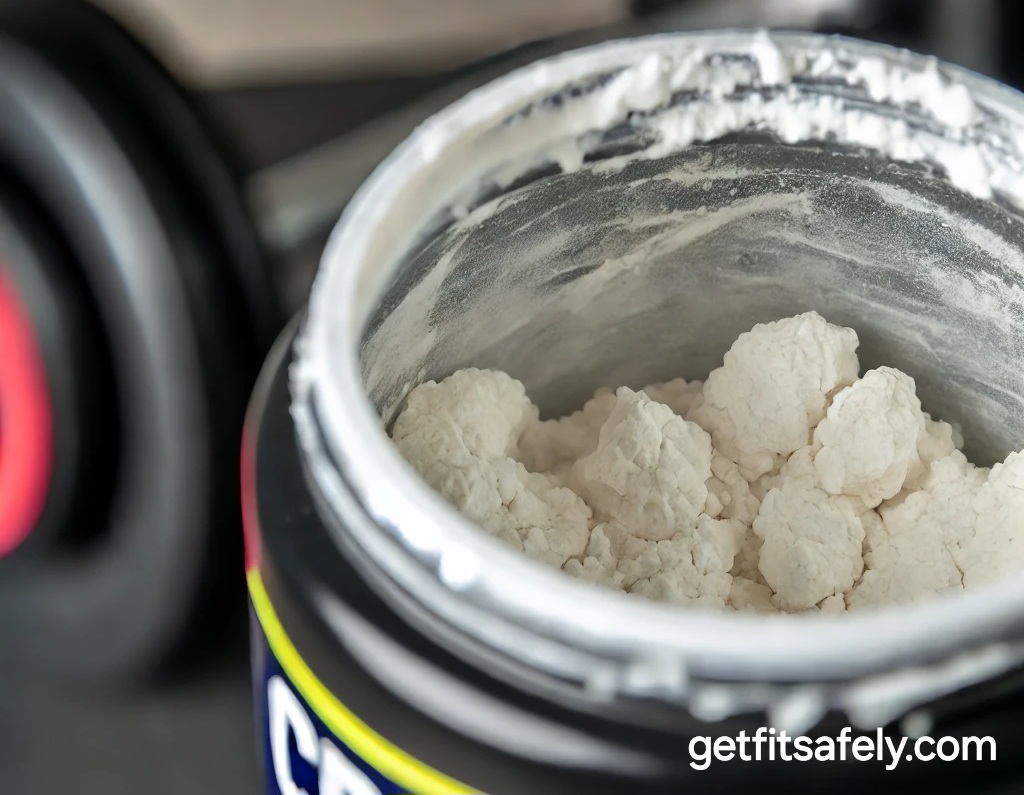So, you jub8st realized that the creatine you’ve been taking is way past its expiration date—like 3 or 4 years old.
Yikes! But before you start freaking out, let’s break it down.
First off, don’t panic.
Creatine isn’t like milk; it doesn’t go bad overnight.
Most supplements, including creatine, are pretty stable.
The expiration date is more of a guideline for peak potency.
That said, if it’s been sitting around for years, there’s a good chance it’s lost some of its effectiveness.
But what about safety?
The good news is that expired creatine isn’t likely to harm you.
It might not work as well, but it’s not going to make you sick.
The worst-case scenario?
You might not get the results you’re after because it’s not as potent.
Still, if you notice any funky smells, changes in color, or clumping, it’s best to toss it.
| 🤔 Aspect | 🔍 Details |
|---|---|
| Safety | Expired creatine is generally safe to consume, but its potency may decrease over time. |
| Effectiveness | After expiration, creatine may not be as effective in enhancing muscle performance. |
| Possible Side Effects | Degraded creatine might cause digestive issues or have an unpleasant taste. |
| Storage Conditions | Proper storage (cool, dry place) can extend creatine’s shelf life, but 3-4 years is beyond typical recommendations. |
| Signs of Degradation | Clumping, unusual color, or strong odors indicate that creatine has degraded and should be discarded. |
Why Creatine Expiration Dates Matter

Alright, let’s cut to the chase.
Why do supplements like creatine even have expiration dates?
It’s not just some random number slapped on the label.
It’s there to make sure you’re getting the full bang for your buck.
Think about it—when you’re throwing back that scoop of creatine, you want to know it’s doing its job, right?
Expiration dates are like a little reminder that your creatine is at its peak power.
After that date, well, it might still work, but it’s not exactly the all-star it used to be.
No one wants to be wasting their time (or money) on something that’s only half as effective.
So, those dates?
They’re your heads-up that your creatine is ready to kick butt—or maybe just take a backseat.
What Happens to Creatine Over Time?
Creatine might seem like a rock-solid supplement, and honestly, for the most part, it is.
But let’s be real—time has a way of messing with everything, even your trusty creatine.
Over the years, I’ve noticed that the once-potent powder can start to lose its punch, and it’s pretty frustrating when you’re not getting the same results as you used to.
So, what exactly changes?
From what I’ve gathered, the creatine molecules can break down over time, turning into something called creatinine, which your body doesn’t use the same way.
This means you’re not getting the full effect you signed up for.
It’s like your creatine is slowly transforming into a shadow of its former self—still there, but definitely not as powerful.
Bottom line?
In my experience, old creatine isn’t necessarily useless, but it’s not delivering the same muscle-boosting benefits you’d get from a fresh batch.
It’s kind of like drinking flat soda—it’s not going to kill you, but it’s definitely not as satisfying.
Safety Concerns: Can Expired Creatine Harm You?
Worried about getting sick from expired creatine?
It’s a common concern, but let’s clear that up with some straightforward facts.
First off, creatine doesn’t spoil like food does.
You’re not going to find mold or bacteria growing in an old tub.
The main issue with expired creatine is that it gradually loses its potency, as it slowly breaks down into creatinine—a byproduct that your body can’t use for performance enhancement.
In terms of safety, consuming expired creatine isn’t likely to make you sick.
It doesn’t turn toxic or harmful just because it’s past its expiration date.
However, if it has been stored improperly—like in a hot, humid environment—it could potentially absorb moisture, leading to clumping or even a funky smell.
If that’s the case, it’s best to toss it out and get a fresh supply.
Quick Recap: How to Tell If Your Creatine Has Gone BadWondering if your creatine has lost its edge? Here’s a quick summary to help you figure out if it’s time to replace that old tub and get a new one.
|
How to Store Creatine to Extend Its Life
Want to keep your creatine fresh and ready to go?
Proper storage can make all the difference.
Here’s how to take care of your creatine the right way:
- Keep It Cool, but Not Too Cool: Creatine isn’t a fan of heat, so keep it in a cool spot—think pantry, not fridge. The fridge might seem like a good idea, but all that moisture? Not so much. Let’s keep it chill, but not that chill.
- Keep It Sealed and Safe: Moisture is creatine’s kryptonite. Keep that lid on tight, and if you’re in a humid area, throw in a silica gel packet for good measure. Your creatine will thank you for the extra protection.
- Airtight and Outta Sight: If you want to go the extra mile, pop your creatine in an airtight container. The original tub is usually fine, but why not give it a cozy new home? Less air, less moisture, more gains.
- Bathroom Cabinet? Think Again: Sure, it’s convenient, but your bathroom is like a humidity factory after those hot showers. Find a new spot—your creatine will appreciate the move.
- Keep It Clean, Folks: Don’t go digging into your creatine with a wet scoop or damp hands. That’s a fast track to clump city. Dry hands, dry scoop, and you’re golden.
Creatine and heat? Not the best combo.If your creatine has been sunbathing too long, it might start to lose its mojo:
|
Various Forms of Creatine: What You Need to Know
Creatine comes in a few different flavors (not literally—unless you count those fruit punch mixes).
Whether you stick with good old creatine monohydrate or try something new, it’s all about what works for you.
Personally, I’m all for the classics, but a little experimenting can be fun—just don’t expect miracles overnight.
Here’s the lowdown on the most popular types:
- Creatine Monohydrate
The classic choice. It’s like the dependable friend who’s always there when you need them. Tons of research backs it up, it’s effective, and it’s usually the most affordable. If it’s working, why change it,right? - Creatine HCL (Hydrochloride)
Got a sensitive stomach? This one’s for you. It’s easier to digest and you don’t need as much, which means less chance of feeling like you’ve swallowed a rock. Plus, it mixes super easily—no more chunky shakes. - Creatine Ethyl Ester
This version claims quicker absorption, but whether it’s better is still up for debate. It’s like the fancy new gadget that promises to change your life, but sometimes you find out your old one works just as well. - Buffered Creatine (Kre-Alkalyn)
If you’re into the idea of a more “stable” creatine, give this one a look. It’s supposed to prevent that creatinine conversion (the useless stuff), but opinions are mixed. - Micronized Creatine
This is creatine monohydrate, just ground up finer. It dissolves better, so if you hate the grit, this one’s your guy. Think of it as the same great creatine, just with a smoother finish. - Creatine Nitrate
Want those muscle pumps? This one’s got you covered by combining creatine with nitrate for better blood flow. It’s newer, so the science isn’t as strong, but if you like to experiment, this might be worth a shot. - Liquid Creatine
Sure, it’s convenient, but here’s the deal—creatine is more stable in powder form. The liquid can lose potency over time, so it’s not always the best bang for your buck.Imagine buying pre-made smoothies—handy, but not as fresh. - Creatine Magnesium Chelate Bonded with magnesium, this type might help with muscle recovery. For those who prioritize faster recovery times, this supplement could offer dual benefits in a single product.
RELATED:>>> Will You Lose Strength and Muscle After Stopping Creatine?
Conclusion:
So, should you really worry if your creatine expired 3-4 years ago?
The truth is, while it’s not ideal, it’s probably not the end of the world either.
Creatine doesn’t suddenly turn toxic after its expiration date, but it does lose its potency.
If you’re serious about your gains, it’s worth considering a fresh batch.
FAQS
How should I store creatine to keep it fresh?
Store creatine in a cool, dry place, away from direct sunlight and moisture. Keeping the lid tightly sealed and using an airtight container can help extend its shelf life.
Is creatine still effective if it has clumped up?
Clumping usually happens due to moisture exposure. While it might still be safe to use, the effectiveness of the creatine could be reduced. Breaking up the clumps and making sure it’s stored properly can help.
Does creatine go bad after the expiration date?
Creatine doesn’t typically “go bad” in the sense of becoming harmful, but it can lose its effectiveness over time. After the expiration date, it may begin to degrade into creatinine, which doesn’t offer the same benefits.
Can I mix creatine with water and store it for later use?
It’s best to mix creatine with water or any other liquid right before consumption. If left mixed for too long, especially in warm or humid conditions, creatine can start to break down into creatinine.


